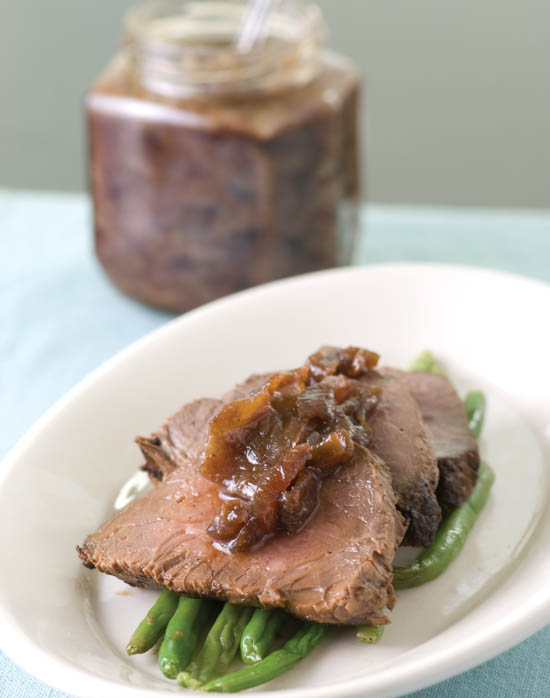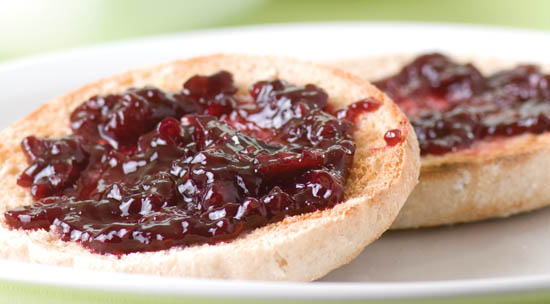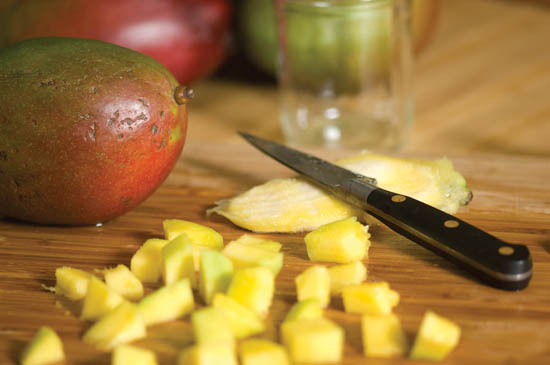Though these are some of the easiest recipes to produce, there are some specifics that must be learned—many more than with complex recipes. Each recipe says to “look for signs of jelling.” Jams will drip off the spatula like water until the pectin begins creating the jelling chains. This is evidenced by elongated drips of slower moving liquid. As seconds pass, this becomes more pronounced. When the last drips have trouble falling from the spatula and actually look like they are jelled, it is getting close to the time to can.
When products are canned prematurely, jelling may take many hours. The fruit that floats to the top of the jar will need to be dispersed over and over again until finally setting up. But there is a fine window when canning jam; if overcooked, the finished product will be rubbery and hard. However, even when done correctly, the whole pieces of fruit will still need to be distributed throughout the jar. After the 2-minute inverted time, each hot jar should be righted and gently shaken to disperse the whole pieces. Keep an eye on the jars and shake every few minutes until jelling locks everything in place.
Also, putting in the sugar when a recipe calls for standard powdered pectin is straightforward, but when one decides to double the recipe, the sugar must be divided and introduced in two stages. First, half the sugar is poured into the pot. The pot is brought to the first signs of a second boil before the remaining sugar is introduced. This process ensures the temperature of the jam does not drop so low as to prematurely begin jelling the product, thus damaging it.
There are other spreads in this category that are not for breakfast as well as some breakfast spreads that are well worth bringing out for other meals. Sweet for meat is a newer sensation. It is a good one, and I dwell on it throughout this volume. Peaches and pork form a union, chicken and raspberries a partnership, duck and orange a marriage. I have experienced apricot jam on flounder, cactus-pear jam with rattlesnake, and onion pepper jelly on burgers. Then there is a goodly assortment ready to work as toppings for the likes of ice cream and cheesecake. If there is only one chapter from which you decide to specialize, make it this one.
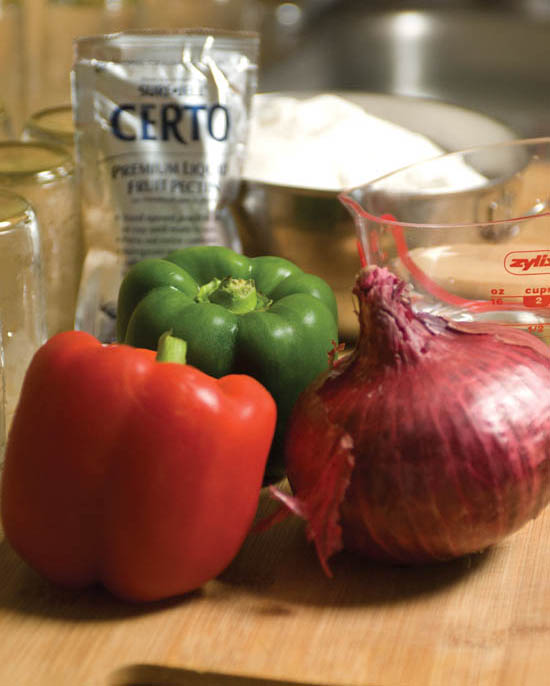
Lemon-Cherry Jell
Cherries, like their early blossoms, release a subtle bouquet of flavors, while the lemon offsets the immense sweetness of this jell by giving it a tart tang. With the taste of sweet and sour, this makes a most versatile preserve.
Canning Notes
This is an acid hot-pack recipe.
pH is not an issue, so testing is not required.
This recipe makes 8 half-pint jars; jar size should not exceed half pint.
This recipe can be doubled but not halved.
Ingredients
| 2 lemons, thinly sliced, seeded but not peeled, each slice quartered |
| 1 cup water |
| 2-1/2 pounds ripe red or yellow cherries, pitted and medium-chopped (for a clear jell, use finely chopped dried cherries) |
| 6 cups sugar |
| 1 pack liquid pectin |
Directions
Place prepared lemon in a nonreactive pot with the water; bring to a boil, reduce heat, and simmer for 5 minutes. Add cherries and sugar. Bring to a rolling boil, add pectin, and bring to a second boil. Time for 3 minutes, but begin checking for signs of jelling halfway through.
When ready, hot-pack into sterilized jars, seal, and invert for 2 minutes only. (When making jam, it is important to not let the jam jar sit upside down for MORE than two minutes! When the jars are first inverted, the fruit will immediately congregate at the surface. As the jelling process begins, each time the jars are turned, the fruit’s ascent to the surface will slow. Watch carefully; when movement has slowed sufficiently, shake the jars to distribute the fruit uniformly. Check again after a few minutes to see if shaking again is necessary. If the jars are not filled prematurely, the fruit sets within 5 or so minutes.)
Serving Suggestions
Lemon cherry jell is one of those special put-up recipes that reaches beyond the breakfast table. It works well as a morning marmalade but makes an excellent addition on top of roast fowl such as chicken, duck, or pheasant. It also plays a nice duet with pork or ham, and removes much of the gaminess from wild venison and boar. It does not stop at the main course or the hunter’s table. Red cherries, yellow lemon rind, and tinted glaze turn a “plain vanilla” scoop of ice cream into something closer to art, pleasing to both sight and palate.
Fruit Marmalade
Not everyone is a marmalade fan, but for those who are, and this includes Ian Fleming’s James Bond, there is no comparison between store-bought and homemade—especially when made with tree-ripened fruit. And even if fruit must be purchased from a grocery store (meaning it is rarely tree-ripened), when competing against the best commercial brands, you will ALWAYS take home the blue ribbon. Why, you ask? It’s simple. Industry brings out the worst. Every manufacturer is competing for your dollar, so price, fancy labels, and pretty jars are foremost in the marketing mind. He has to advertise, pay his employees, pay his rent, and, don’t forget, make a profit; his distributor requires a profit; and the retailer often demands more than all the others combined. Guess how this comes together to work? Cheap ingredients!
Canning Notes
This is an acid hot-pack recipe.
pH is not an issue, so testing is not required.
This recipe makes 14 half-pint jars; pints can be used but jelling will be slow.
This recipe can be halved but not doubled.
Ingredients
| 8 cups fruit (lemon, orange, grapefruit,* individually or in combination) |
| 3 cups water |
| 2 packs pectin |
| 11 cups sugar, divided |
Directions
Thinly slice and seed the lemons and/or oranges. For the grapefruit (if used), the membranes between the plugs are tough and must be removed. Peel off the outer skin of the fruit, reserving only half. Cut each grapefruit in half and then cut between each plug and around the outer perimeter; spoon out the plugs and put aside after measuring. Cut any excess white pith from the reserved skins and slice into strips approximately 1/16 x 1/4 to 1/2 inch.**
Place the lemons, oranges, and grapefruit rind in the canning pot; add the water and bring to a boil. Reduce heat and simmer for 10 minutes.
Add the grapefruit plugs (if used) and pectin, and turn heat to high. Bring to a rolling boil, holding for 1 minute before adding half of the sugar. Bring to the beginning of a second boil before adding the remaining sugar. Bring to a fierce rolling boil and begin timing for 2 minutes. Check for signs of jelling after the first minute.
Once proper jelling is assured, remove from heat and quickly ladle into sterilized jars, making sure each gets a fair share of each fruit. Seal and invert for 2 minutes only. When jars are placed upright, gently shake the jars periodically until jelling sets the pieces of fruit.
Serving Suggestions
It goes without saying that marmalade on toast or English muffins is a morning delight. But marmalade hardly stops at breakfast! When chicken is baked, broiled, fried, or rotisseried, then slathered with a top-quality marmalade, the simplest and least expensive of birds is turned into one of those meals a family will demand again and again. The same goes for pork chops. Stir a teaspoon of crushed red pepper flakes into a half cup of jam just to fire up the taste. Use your imagination. Whatever pairs well with sweet will work well with marmalade. Try it on flounder!
*Limes can be added or substituted; however, lime rind is really tough and must be removed and cooked with baking soda as described below for 20 minutes. A lime-grapefruit marmalade makes a pleasant yet unique spread as well as a world-class addition to many a mild white fish.
**To avoid the toughness of the rind, peel all the fruit with a peeler and reserve the rind after removing any remaining white pulp. Cut the strings of rind into short strips and dump some or all into a pot with 2 cups of water and 1/8 teaspoon of baking soda. Bring to a boil, reduce to a simmer, and cook for 10 minutes (if using lime, see further directions above). Rinse and drain well. If it is the bitterness of the rind you want to avoid, peel and discard the rind; but when cutting the slices of fruit, leave the sections larger, for they will break down during the cooking process.
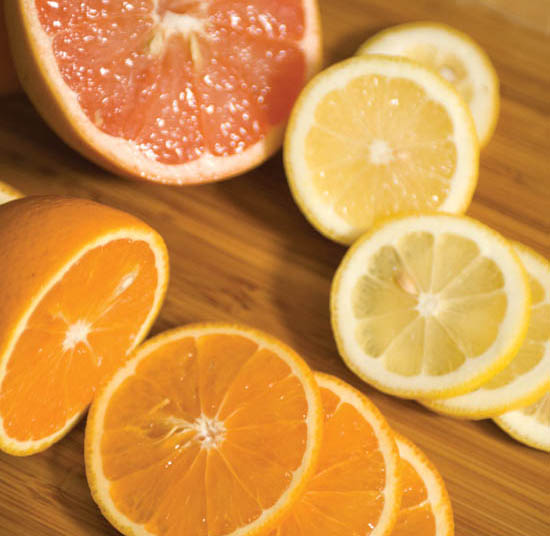
Orange-Fig Marmalade
For the thousand years before commercial enterprises began turning out bleached white sugar, families used honey to sweeten their food. Back then, many lived on farms and society was agrarian. The honey used was a by-product of a farm denizen as necessary as the mule—the bee. These were maintained to pollinate crops, the wax from the hives was turned into candles for light, and, lastly, the nearly forgotten honey was used as a sweetener. The Civil War in our country was a clash between two societies, agrarian and industrial, a sort of honey versus white sugar. White sugar won, but remember, honey has a long-range positive effect on our bodies that other sweeteners do not.
The delicate flavors of yellow figs and the lasting freshness of oranges combine to make a great presentation, while the recipe provides a bit of nostalgia as we remember, through our taste buds and our genes, families sitting around farm tables having breakfast, eating fresh home-baked breads with home-churned butter and homemade preserves spread on top.
Canning Notes
This is an acid hot-pack recipe.
pH testing is not required.
This recipe makes 6 half-pint jars; half-pint and pint jars are best suited for this recipe.
This recipe can be halved only.
Ingredients
| 6 cups stemmed and quartered figs |
| 2 cups water |
| 2 thin-skinned oranges, sliced, seeded, and slices quartered |
| 2 lemons, sliced, seeded, and slices quartered |
| 4 cups honey |
| 2 packs liquid pectin |
Directions
Place the figs in a canning pot with the water, bring to a boil, and simmer for 10 minutes.
Add the citrus fruits and the honey. Bring all to a rolling boil. Add the pectin, return to a boil, and, after 1 minute, begin checking for signs of jelling. Jams made with honey never jell like jams with sugar but, still, signs will show.
When ready, ladle into sterile jars, seal, and invert for 2 minutes only.
Serving Suggestions
Fig jam is a very popular breakfast spread. As a marmalade, it will be the star of the morning table; as an hors d’oeuvre over Brie, it is a party stopper; and for cooking, use on pork tenderloin, pork chops, and chicken after coming off the heat source.
Red Tomato Jam / Red Tomato Marmalade / Red Tomato Conserve
When we think preserves, we think fruit. So, yes, these three recipes are right on target. The tomato might be more commonly considered a vegetable, but, in fact, it is a fruit or, more specifically, a berry. It is the highest pH fruit and creates the division between fruits and vegetables. It is only fitting then that we make a preserve. Like all fruits, tomatoes are sweetest when picked blood-red ripe. So this becomes the standing prerequisite for great jam, no exceptions.
Unlike the seeds in many berries like blackberries, tomato seeds lend bitterness to the finished spread, so it is best to remove as many as you can. Excessive juice means longer cooking times, which equates to reduced flavor. So after peeling (by scalding in boiling water for 1 minute, see peeling section in introduction), core and halve the tomatoes by cutting through their “equators,” not their “poles.” This exposes the five or so seed cavities. Squeeze out the juice and most of seeds will flush with it. A finger in each crevice will chase out any recalcitrant cling-on seeds. End result—no bitter taste, cooking time is shortened so flavors are enhanced, and jelling will occur much faster.
Red Tomato Jam
Canning Notes
This is an acid hot-pack recipe.
pH is not an issue, so testing is not required.
This recipe makes 10 half-pint jars; half pints are best suited for this recipe.
This recipe can be halved only.
Ingredients
| 8 cups tomatoes, peeled, cored, juiced, seeded, and chopped medium (about 5 pounds) |
| 2 lemons, seeded and chopped fine, or 1/4 cup lemon juice |
| 2 packs pectin |
| 1 teaspoon allspice |
| 10 cinnamon sticks |
| 1/2 tablespoon butter (optional) |
| 8 cups sugar |
Directions
Cook prepared tomatoes at a slow boil in a nonreactive canning pot for 20 minutes.
Measure out 6 cups of the finished tomatoes and discard the remainder. Add the measured tomatoes to the pot plus all remaining ingredients except the sugar and bring to a strong boil.
Add the sugar and return to a rolling boil that cannot be stirred down. Remove the cinnamon sticks and place 1 in each canning jar. Time the boil for 1 to 1-1/2 minutes, keeping an eye out for good jelling signals.
Pour into sterile jars, seal, and invert for 2 minutes only.
Red Tomato Marmalade
Canning Notes
This is an acid hot-pack recipe.
pH is not an issue, so testing is not required.
This recipe makes 10 half-pint jars, which are best suited for this recipe.
This recipe can be halved but not doubled.
Ingredients
| 7 cups peeled, halved, squeezed, seeded, and chopped tomatoes |
| 1 orange, peeled, sliced, seeded, and slices quartered |
| 1 lemon, peeled, sliced, seeded, and slices quartered |
| 1/2 teaspoon cinnamon |
| 1/2 teaspoon allspice |
| 2 teaspoons lemon zest (optional)* |
| 2 teaspoons orange zest (optional)* |
| 2 packs pectin |
| 1 tablespoon butter |
| 12 cups sugar, divided |
Directions
Place tomato chunks in a pot over medium heat and simmer for 15 minutes, stirring continuously.
Add remaining ingredients except sugar, turn heat to high, and continue to stir. When a rolling boil begins that can no longer be stirred down, add half the sugar. As boiling begins for a second time, add the remaining sugar and, stirring constantly, return to a full boil. Continue stirring while timing for 2 minutes. Check for strong jelling signs after 1-1/2 minutes.
When jelling is assured, remove from heat. Pour into sterile jars, seal, and invert for 2 minutes only.
*Some folks love rind while others abhor the bitterness. Any marmalade aficionado will add the rind.
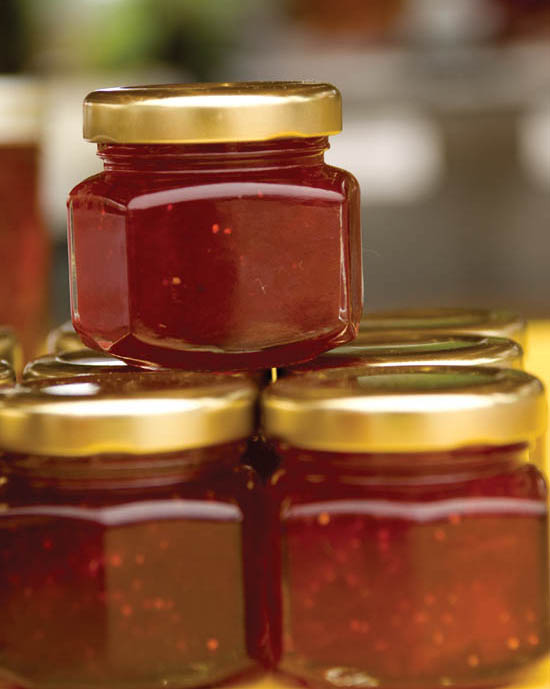
Red Tomato Conserve
Canning Notes
This is an acid hot-pack recipe.
pH is not an issue, so testing is not required.
This recipe makes 8 half-pint jars, which are best suited for this recipe.
This recipe can be halved but not doubled.
Ingredients
| 6 cups peeled, cored, juiced, seeded, and chopped medium tomatoes |
| 2 cups fresh blueberries, errant stems removed |
| 1/4 cup freshly squeezed lemon juice |
| 2 packs pectin |
| 1/2 tablespoon butter (optional) |
| 8 cups sugar |
Directions
Place tomato chunks in a pot. Over low heat, simmer for 10 minutes, stirring continuously.
Add remaining ingredients except sugar and continue to stir. When a rolling boil begins that can no longer be stirred down, add the sugar. Stirring constantly, return to a full boil. Continue stirring while timing for 2 minutes. Check for strong jelling signs after 1-1/2 minutes.
When jelling is assured, remove from heat. Pour in sterile jars, seal, and invert for 2 minutes only.
Serving Suggestions
It goes without saying that these three contenders will find their way onto many a breakfast table. But breakfast is only a first daily performance for this trio. I like to serve good food in a presentation that is pleasing to the eye, especially if I can also avoid being a slave to the preparation. If I can enjoy art for dinner, I’ll do it, especially if there is no extra mile.
One of my favorite summer salads is a simple layered spread of ripe tomato slices topped with sliced medallions of mozzarella cheese and basil leaves on top, all aligned across a plate with the discs overlapping by half the length of the plate. Spill a small puddle of quality olive oil above the top starting point and drizzle balsamic vinegar into the center. Repeat this at the end of the tomato line but below. When all is fresh, this is a truly divine and refreshing dish—so much so that I hate to have to wait all winter to enjoy it. In comes tomato jam or marmalade! Winter tomatoes never have that bright red look of summer tomatoes nor do they have much taste, so I supercharge the same salad by spooning a line of the preserves or marmalade along the center. The sweet taste of fresh tomatoes returns and the salad becomes a year-round enjoyment.
Another great suggestion—use the tomato preserves on a sandwich! A tomato slice on a chicken salad sandwich made in the morning for lunch at the office turns even the best breads into soggy paste after four hours of capillary action. But, with lettuce below and tomato preserves instead of the tomato above, the sandwich bread remains as it was when sliced—a perfect sandwich.
As with many of these recipes in this book, the limit is one’s imagination. There are no big red circles with a diagonal red line intimating “Not for use on chicken, etc.”
Rainbow Pepper Jelly
Green bells have twice the vitamin C of a tree-ripened orange, and red bells have four times. All peppers start out green; but the varieties that continue on to other colors are not picked green, because they will command a higher price later even though they will perish sooner. They are also sweeter than green. As pepper season arrives, all bells plummet in price, making these put-up delectables a most reasonable canning opportunity. Pepper jellies have arrived, front and center, and are a mainstay of home entertaining. The reason is obvious, the hors d’oeuvre is prepared quickly and is always appreciated. The problem with store-bought jellies is that they lack in taste, but the simplest home-prepared jelly explodes with flavor. This is another chance to shine as a home canner.
Canning Notes
This is an acidified, sugar-saturated, hot-pack recipe.
pH is not an issue, so testing is not required.
This recipe makes 12 half-pint jars; half pints are best suited for this recipe.
This recipe can be halved but not doubled.
Ingredients
| 1 cup seeded and deveined, medium-diced green bell pepper* |
| 1 cup seeded and deveined, medium-diced red bell pepper |
| 1 cup seeded and deveined, medium-diced orange bell pepper |
| 1 cup seeded and deveined, medium-diced yellow bell pepper |
| 1 cup seeded and deveined, medium-diced purple bell pepper |
| 3 cups white vinegar (distilled) |
| 2 tablespoons red pepper flakes |
| 13 cups sugar |
| 1 tablespoon butter |
| 2 packs liquid pectin |
Directions
Place all ingredients except the pectin in a nonreactive pot. Bring to a rolling boil for 1 minute. Add the pectin and, when the second rolling boil commences, begin a 2- to 3-minute count. After 1 minute, begin checking for signs of jelling. (It is important not to can pepper jelly prematurely or, even if canned in the a.m., you will be shaking jars well into the night. It is equally important not to overcook or the finished jelly will be tough and rubbery.)
When just right, ladle into sterile jars, seal, and invert for 2 minutes only.
Serving Suggestions
Pepper jellies have been served at gatherings for the better part of the twentieth century. Spooned over cream cheese, there remains little that is faster to prepare. I have tried them all, and water crackers are by far the best accompaniment for this hors d’oeuvre. But this colorful jelly can be used very successfully as a topper to cooked white fish, chicken, and pork. Or add a spoonful to a burger and watch smiles break out.
*If heat is desired, reduce the green bell pepper by half and add 1/2 cup green jalapeños.
Blackberry-Lemon Marmalade
The season of berries is an exciting time. There is nothing quite like the flavor of freshly picked ripe berries. Every region has its wonders. In coastal Maine, it’s the tiny wild blueberries. In the Northwest, blackberries are definitely world-class. When I lived in Seattle, my yard was fenced because of a pool, and the fence was surrounded by bramble. I was considering clearing it all out when I noticed big black buds on the stickers. I investigated, picked, ate, and then pigged out. By season’s end, I looked like I’d spent a week chasing Brer Rabbit through the briar patch. So sweet are freshly picked ripe blackberries that the addition of lemon adds just enough tartness to give an exciting and complementary flavor to one of my favorite fruits. We introduced this recipe at a farmers market one July. It has been in high demand ever since.
Canning Notes
This is an acid hot-pack recipe.
pH is not an issue, so testing is not required.
This recipe makes 14 half-pint jars; half pints are best suited for this recipe.
This recipe can be halved but not doubled.
Ingredients
| 8 cups blackberries, rinsed and partially crushed |
| 3 lemons, seeded and chopped into pea-size chunks |
| 2 packs pectin |
| 1 tablespoon butter |
| 13 cups sugar, divided |
Directions
Place the blackberries and lemons in a nonreactive pot with the pectin and butter, and bring to a strong boil. Add half the sugar. When the mixture shows further signs of beginning a second boil, add the remaining sugar and bring to a fierce rolling boil. Begin timing for 2 minutes and then watch for signs of jelling. Depending on the water content in the berries, jelling signs may take longer.
When ready, ladle into sterile jars, seal, and invert for 2 minutes only.
Serving Suggestions
This is a breakfast delight. Because I have so many diverse canned items, and because I enjoy this marmalade in the morning, I seldom use it elsewhere. However, I once tried dumping a whole jar over a big wedge of Brie at a fund-raiser. I was surprised to see the crowd that gathered around my little black-and-white offering while forsaking more traditional canapés. Coming home that night, I opened another jar and painted it on a skinless chicken breast as it came off the grill. It was then I knew I’d be running out of blackberry marmalade long before any berries were again ripe for picking.
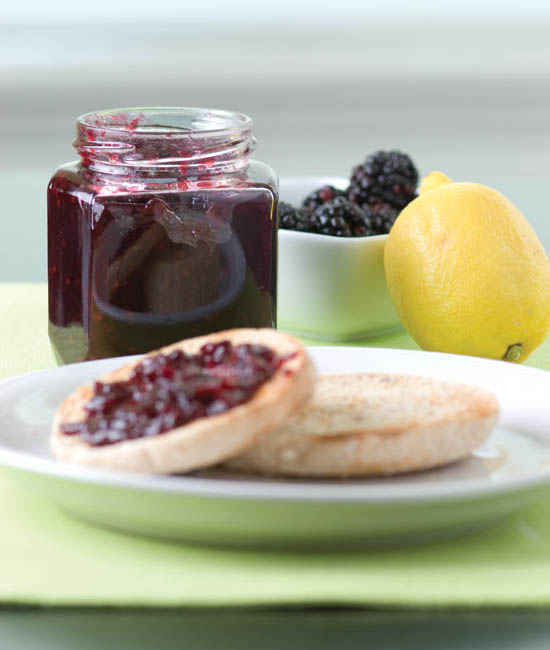
Blueberry Marmalade
In my neck of the woods, fresh blueberries herald the summer like strawberries announce the spring. But it matters little when these tiny sweet berries come of age; when they do, a season changes for the better and so does our health, because blueberries are a super antioxidant. My first book offers the basic preserve while this book has the more complex marmalade. Every pantry should contain some of both.
Canning Notes
This is an acid hot-pack recipe.
pH is not an issue, so testing is not required.
This recipe makes 12 half-pint jars, which are best suited for this recipe.
This recipe can be halved but not doubled.
Ingredients
| 5 cups blueberries, partially crushed |
| 3 thin-skinned oranges, stem ends cut off, seeded, and roughly chopped* |
| 2 lemons, stem ends removed, seeded, and roughly chopped* |
| 2 packs pectin |
| 1 tablespoon butter |
| 11 cups sugar, divided |
Directions
Place the fruit, pectin, and butter into a nonreactive pot over high heat. Stir often while bringing to a substantial rolling boil. Hold for 1 minute before adding half the sugar. Return to a boil and add the remaining sugar. When a rolling boil commences a second time, begin a 2-minute count. Check for signs of jelling. It may take another minute, depending upon the water in the berries. When ready, pour into sterilized containers, seal, and invert for 2 minutes only.
Serving Suggestions
Of course this is a breakfast delicacy. There is nothing quite like fresh blueberry marmalade on an English muffin, crumpet, or just plain old toast, although many are beginning to admit specialty breads like Ezekiel have raised the bar. But this spread does not have to be stashed once breakfast is history, for it works well over vanilla ice cream too. My favorite usage, along with a plethora of other homemade preserves, is to fold the marmalade within an omelet along with a small block of cream cheese. Want to get fancy? The French might call this oeuf au confiture. My granddaughter, Ashley, calls it a cream-cheese-and-jelly omelet, and it always guarantees a return visit.
*Cut the fruit into slices so each can be adequately seeded and then run through a processor to chop into large chunks, or slice, seed, and quarter the slices.
Prickly Pear Cactus Jelly
My introduction to this unusual delight came when I was visiting the Grand Canyon. The enormity and natural beauty was so magnificent that I burst into tears at my first glimpse. I have traveled all over the world, but nothing got to me quite like our natural wonder. A few nights later in a restaurant in Flagstaff, Arizona, I had a rattlesnake appetizer with cactus pear jelly. Wow, I began to wonder if Arizona had it all: the Grand Canyon, cactus, rattlesnakes, and wonderful residents.
Canning Notes
This is an acid hot-pack recipe.
pH is not an issue, so testing is not required.
This recipe makes 5 half-pint jars; half pints are best suited for this recipe.
This recipe can be doubled but not halved.
Ingredients
| 3 cups prickly pear juice* |
| 1/4 cup freshly squeezed lime juice |
| 4 cups sugar |
| 1 pack liquid pectin |
Directions
Add all ingredients except the pectin to the canning pot and bring to a strong boil. Add the pectin and return to a rolling boil. Time for 1-1/2 minutes. Watching for jelling signs after 1 minute.
When ready, pour into sterile jars, seal, and invert for 2 minutes only.
Serving Suggestions
Once again it is the sweet and meat combination. Rattlesnake meat, both bone in and boneless, is available online; but the cost, beginning at nearly $60 a pound, is prohibitive. Best leave that one to regional cuisine. Still, the jelly is unique, wonderful tasting, great on morning breads, and, since rattlesnake tastes like chicken . . . well, you get the idea.
*6 cups of the cactus fruit makes about 3 cups of juice. Wash and scrub the fruit, taking care not to get skewered by the spines. These will soften during cooking and will be strained off later. Quarter the fruit and place in a pot with just enough water to cover. Mash the quartered fruit with a potato masher, bring to a boil, reduce heat, and simmer for 30 minutes. Strain with a fine sieve or several layers of cheesecloth. Measure 3 cups and discard any remainder.
Mango Preserves
It is rare that one finds mango preserves for sale. It is no wonder, the large bulk fruit has a thick skin and a big pit resembling a cuttlefish bone one finds in a canary cage. Of all the fruits, mango to me is the most luscious. On our tiny sailboat, coasting south along Central America, my son and I would spyglass the distant shoreline, looking for mango and coconut trees. It was always worth the effort to anchor beyond the breaking surf and swim ashore to gather nature’s fallen wild bounty. In Panama, we often wondered why local children so full of energy didn’t climb the trees to get the fruit. They just stared, hoping for fruit to fall. Little did we know that one does not climb the mango. The first time I sent my son up one of these trees, he threw down fruit to ecstatic but mouth-agape kids. It was shortly thereafter that we learned of the miserable side effect of climbing the mango tree. It is a member of the sumac family and, like poison ivy, can leave a climber miserable for a time.
Canning Notes
This is an acid hot-pack recipe.
pH is not an issue, so testing is not required.
This recipe makes 8 half-pint jars; half pints are best suited for this recipe.
This recipe can be doubled but not halved.
Ingredients
| 6 cups peeled and seeded, small-chopped mango* (about 6 pounds whole fruit) |
| 1/4 cup freshly squeezed lime juice |
| 6 cups sugar |
| 1/2 tablespoon vanilla |
| 1 pack liquid pectin |
Directions
Place the prepared fruit in a nonreactive pot with the lime juice, sugar, and vanilla. Bring to a rolling boil before adding the liquid pectin. Bring to a second boil and time for 2 minutes (3 if recipe is doubled), and then watch for signs of jelling.
When ready, pour into sterilized jars, seal, and invert for 2 minutes only.
Serving Suggestions
Like all preserves, this goes well with breakfast. The mango is a tropical fruit and therefore makes a marvelous complement to more exotic tropical or Caribbean meals. For example, trigger fish fillets coming off the grill with a dollop of mango preserves alongside each plate is island heaven. Try it—I guarantee when the plates are collected, there’ll not be a drop of preserve or fish on any plate. As a steamy summer supper or as a luncheon salad, cold-cook red snapper cubes in a ceviche (or citrus) marinade and finish each plate by placing a tablespoon of the preserve on top of the serving. Never a negative comment will be heard, just plenty of kudos.
*There is a stringy fiber within mango pulp, and this is the reason for chopping it into small thumbnail pieces.
Red Cherry Preserves
There was a time many years ago when I vividly recall driving in our family convertible through the Yakima Valley in Washington State, gorging on just-picked cherries bought from roadside stands while giggling kids in the backseat spat pits straight up to catch the airstream above. These were fun adventures in the simplest of times, often the best of life. Fresh cherry preserves are a delight, both as a breakfast spread and as a condiment for all things pig, fowl, and fish. I never fail to make two double runs of this preserve and yet always run out even before cherry blossoms herald the coming of spring.
Canning Notes
This is an acid hot-pack recipe.
pH testing is not required.
Recipe makes 8 half-pint jars; half pints are best-suited for this recipe.
This recipe can be doubled but not halved.
Ingredients
| 5 cups pitted and chopped cherries* (Bing or equivalent), about 4-1/2 pounds |
| 1/4 cup freshly squeezed lemon juice |
| 5 cups sugar |
| 1/2 tablespoon butter |
| 1 pack pectin |
Directions
Place the fruit in a pot with all but the pectin and bring to a rolling boil. Add the pectin and return to a rolling boil. Begin a 2-minute time count and watch for jelling after 1 minute.
When ready, pour into sterile jars, seal, and invert for 2 minutes only.
Serving Suggestions
The cherry preserve stash in the pantry will work well for any meal. The deep red of cherry preserves goes so well against the anemic white of oven-cooked pork and fowl that I often cannot help but add a dollop to brighten up the plate.
*Cherry juice stains! So, when you begin the task of pitting fruit, wear old clothes and have a damp cloth ready to mop up spilt juice. The chore goes quickly. Using just your fingers, break open the cherry and squeeze out the pit. When juice spits out, quickly wipe down the backstop, wall, or cabinet. Later, put Clorox in the water to clean your counters and fingers as you sterilize the jars.
Apple Conserve
Fall is apple time. I often wonder if the third quadrant of our calendar was not named for the action of apples in September! Or could it be that Newton named the season?
Sinfully delicious, apples are truly one of God’s gifts to mankind. And yet only a handful of us recall the story of Johnny Appleseed. By the time he got to the West, apple trees were flourishing nationwide. Apples grow in many states and many climates, and boxes of them find their way to grocers all across our land in all seasons because the fruit stores so well. If you are blessed with a tree or live in a region where apple trees flourish, take advantage. If not, don’t be disheartened—as with Eve, a great apple is always within reach.
A conserve is like a jam or preserve but with added fruits and flavors to make it complex. The complex flavors of this recipe are perfect for a crispy autumn morning breakfast biscuit or toast, but on a pork chop, it is like a coronation crowning.
Canning Notes
This is an acid hot-pack recipe.
pH testing is not required.
This recipe makes 7 half-pint jars; half pints are best suited for this recipe.
This recipe can be doubled but not halved.
Ingredients
| 5 cups peeled, cored, and chopped red tart apples, like Winesaps (about 7 pounds) |
| 1 cup water |
| 2 thin-skinned lemons, thinly sliced, seeded, and slices quartered |
| 1/2 cup chopped dried cherries |
| 1/2 cup chopped nuts (almonds, pecans, walnuts, cashews, etc.) |
| 1 pack pectin |
| 6 cups sugar |
Directions
Place all ingredients except the sugar in a nonreactive pot. Bring to a rolling boil, add sugar, and return to a rolling boil before beginning a 2-minute count. Watch for jelling signs after 1 minute.
When proper jelling is assured, pour into sterile jars, seal, and invert for 2 minutes only.
Serving Suggestions
I like to usher in each new month and season with new recipes I have just put away. For my granddaughter, it is a way of saying not only has a new month arrived, but also new and exciting recipes await her developing little palate. I make a lot of preserves, so I decided I’d try this one with a new medium. I warmed some of the conserve until soft and then poured it over apple fritters. As with ancients honoring a harvest, the apple took center stage. Another presentation is to put a tablespoon of conserve over a scoop of vanilla ice cream. Surprise everyone at the table, but be prepared to be asked for several additional spoonfuls before each scoop is gone. And lest we forget the preamble, one will never view a pork chop in quite the same light again.
Apple Butter
The term butter is derived from the way a product spreads—not what is in the mix. Unlike jams and jellies prepared in kitchens, six or eight jars at a time, the harvesting of apples is celebrated with a preparation of butter. Whole apples are cooked down in huge copper cauldrons while being stirred with a wooden paddle fit for canoeing. Slowly cooked for long periods (eight hours or more) and using the skins and cores to provide the necessary pectin, apple butter contains little sugar by comparison to sauce or jam. Apples can be added and mixed and matched for quantity, added sweetness, bitterness, and flavor. Likewise, just before canning, a portion of the butter could be made into a conserve by using either dried or acid ingredients only, like fruit (but no more than a cup per single recipe) to be safe.
Although this recipe can be multiplied into the hundreds of pounds without increasing the surface area of the pot and the BTU’s of heat, the breakdown of the apples could take much longer, maybe days. Two suggestions: use a bigger pot, maybe twice as big when making a double run, or make two single runs simultaneously.
Canning Notes
This is an acid hot-pack recipe.
pH testing is not required.
This recipe makes 8 half-pint jars; half pints are best-suited for this recipe.
This recipe can be doubled or multiplied but not halved (see caveat in “The Recipes” sidebar).
Ingredients
| 6 pounds apples, mixed but none overly sweet, quartered |
| 1-1/2 cups apple juice, freshly pressed or juiced (not pasteurized) |
| 3 cups sugar (brown is optional but is richer and changes the flavor), or 2-1/2 cups honey |
Directions
Cook apples in juice for 20 to 30 minutes until soft, mushy, and coming apart.
Press thru a strainer, food mill, or sieve, leaving behind stems, cores, seeds, and skins. Add strained sauce to a pot with sugar or honey, bring to a boil, and reduce heat. Stir periodically on low; stir more frequently on medium low; and stir nearly constantly on medium, knowing that the job will get done much faster.
When the butter is thick, ladle into sterile jars, seal, and invert for 2 minutes only.
Serving Suggestions
Use like preserves. Apple is a wonderful addition to all things pork, and I am not the first one to discover this. I’ve been seeing roasted whole pigs with apples stuffed in their mouths my entire life. When serving a roast pork dish like tenderloin or chops, place a ramekin with about 2 ounces of apple butter in the center of each plate just for dipping. Simple, easy to fix, and healthy—the kids will thank you for it. So will grown-ups!
Persimmon Jelly
Persimmon was at one time far more common a tree than we see today. The reason? It’s kin to ebony, an extremely hard, fine-grained wood that was used to make the heads of golf clubs (woods or long-range drivers). The near fate of the persimmon tree is not alone. Can you believe the giant redwoods were nearly almost all converted into cigar boxes! My, how we can be a thoughtless nation of excesses sometimes.
I love to watch young people bite into a ripe persimmon for the first time. The look of fear over trying something new gives way to exploration after they bite through the waxy astringent skin and the first sweet juices, unlike anything they might have ever tasted, hits the palate and blossoms in their mouth. You just know they are thinking, “I need to get a lot of these.” Too bad they are so expensive. Ripe fruit perishes rapidly, so persimmons must be picked unripe for commercial markets. This can be a turnoff. Then there is the feel of the meat on the palate. Peaches might have their fuzz, but persimmons have this strange waxy alkaline feel on the tongue and cheeks, and the interior has a slimy texture—all challenges when made into preserves, so this is an ideal candidate for a jelly, something I rarely do.
Canning Notes
This is an acid hot-pack recipe.
pH testing is not required.
This recipe makes 4+ half-pint jars; half pints are best suited for this recipe.
This recipe can be doubled but not halved.
Ingredients
| 4+ pounds ripe persimmons, blossoms removed and fruit quartered |
| 2-1/4 cups water |
| 3 tablespoons freshly squeezed lime juice |
| 1-1/4 cups honey |
| 1 pouch liquid pectin |
Directions
Place fruit in a nonreactive pot. Add water and bring mixture to a boil. Mash the persimmons with a potato masher, reduce heat, and simmer 15 minutes. Remove from heat.
Press pulp through a strainer to remove pits, and then measure 3-1/2 cups juice. Discard any remainder. Stir in the lime juice and honey (heated honey pours better and leaves less behind). Bring mixture to a rolling boil. Add the pectin and return to a rolling boil for 2 minutes before beginning jell testing.
When signs of jelling are assured, pour into sterile jars, seal, and invert for 2 minutes.
Serving Suggestions
I don’t want to insult anyone’s intelligence here. We all know what to do with jelly! But just the same, I am one who gets bored quickly with the spread on toast or English muffin routine, and I have a pantry stuffed full of jars to use on meat, fish, and fowl. So let’s say we try something outside the standard cooking envelope as an added benefit. Because the jelly is without fruit chunks and is opaque, it can be used invisibly to subtly yet uniquely flavor without an overpowering tour de force. One such way is to add persimmon jelly to homemade chili. Recall my discussions on sweet and meat.
Onion-Pepper Jelly
There is a pepper jelly for every occasion: plain bell pepper, hot pepper, garlic pepper, pepper-specific like jalapeño or habanero pepper, and even multi-pepper like seven-pepper jelly. There are endless combinations, but all contain three common ingredients: vinegar, sugar, and clear liquid pectin. Many of these creations come in pretty colors, and I am often asked if I have green or red pepper jelly, to which I always respond with a resounding “NO!” simply because I detest chemicals, and colored pepper jellies are dyed with food coloring (some colors have recently been determined unsafe).
This onion pepper jelly has a little of both red and green bell peppers to give it color as well as depth of taste, but there is a predominately and commanding onion flavor with the sweet, making it an hors d’oeuvre general as well as a cooking condiment colonel.
Canning Notes
This is an acidified, sugar-saturated, hot-pack recipe.
pH testing is not required.
This recipe makes 7+ half-pint jars; half pints are best-suited for this recipe.
This recipe can be doubled but not halved.
Ingredients
| 1-1/2 cups medium-diced red onion |
| 1/2 cup medium-diced red bell pepper |
| 1/2 cup medium-diced green bell pepper, or 1/2 cup seeded and finely chopped jalapeños |
| 6-1/2 cups sugar |
| 1-1/2 cups distilled vinegar |
| 1/2 tablespoon butter |
| 1 pouch liquid pectin |
Directions
Prepare the onion and peppers and place in a nonreactive pot with the sugar, vinegar, and butter. Bring to a rapid rolling boil. Add the pectin and return to a rolling boil before beginning a 1-1/2-minute count. Check for signs of adequate jelling after 1 minute.
When ready, pour into sterile canning jars, seal, and invert for 2 minutes only.
Serving Suggestions
If the cheese is the thing with which we’ll catch the interest of the king (just to twist the great bard’s words), then the cheese to use might be English Stilton. However, one can always use cream cheese. Spoon this jelly over a favorite cheese and serve with water crackers for a showstopping hors d’oeuvre. For cooking, the usual suspects are chicken, pork, and even cuts of red meat work; but go outside the box by experimenting with a giant portabella mushroom steak. Paint the tops and bottoms of each mushroom with olive oil, place top down in a 425-degree oven, and bake for 18 minutes. Remove, sprinkle the inside well with cheddar cheese, and add a small amount of minced purple onion on top along with green and red bell pepper stripes. Return to the oven just long enough for cheese to melt, remove, and place a tablespoon of onion-pepper jelly in the center to complete your masterpiece.
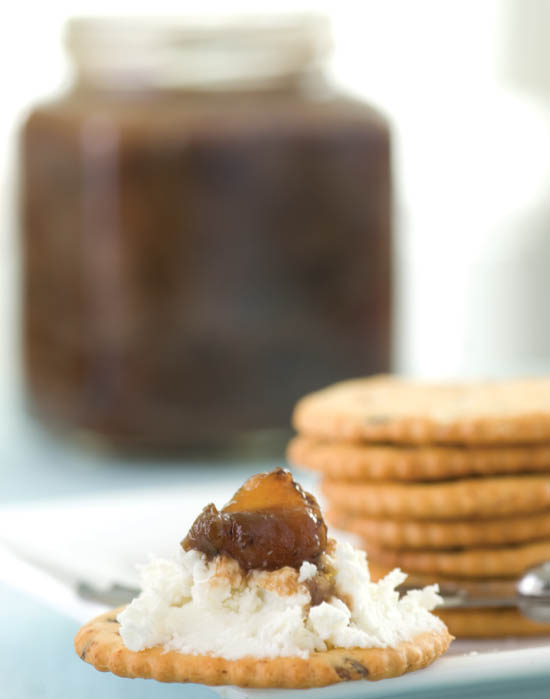
Sweet Onion Jam
Not all jams belong on the breakfast table. This is one that does not. Sweet onions differ from their eye-watering, breath-tainting cousins in that they hold more water and consequently less of a sulfuric smell. When I lived in Seattle, there was always a Walla Walla Sweet somewhere to be had. Other locales have theirs, with Maui producing maybe the sweetest and Vidalia (through marketing) producing one of the best known. But in California, it’s the Sweet Imperial; in Arizona, the Grandex; in New Mexico, the Nu Mex Sweet; and in Texas, a big, big onion called Tex Sweet. The Spanish Sweet is not so sweet; though great for preparing other dishes while not crying over the prep, don’t use them for this recipe because they’re just not sweet enough.
It’s fun to be unique, especially when one delivers something unusual and yet extraordinary. So it will be with sweet onion jam. Easy to make and with a plethora of uses, this simple, iron-rich, put-up delectable will add a new kind of excitement to hamburger and steak dinners.
Canning Notes
This is an acidified hot-pack recipe.
pH will be below 4. To reduce, add additional vinegar in small amounts.
This recipe makes 3+ half-pint jars, half pints are best-suited for this recipe.
This recipe can be doubled, but read prep instructions first.
Ingredients
| 1/4 cup butter |
| 3 tablespoons olive oil |
| 4 pounds sweet onions, thinly sliced, and slices quartered |
| 1 cup sugar (raw or white) |
| 1/2 cup dark brown sugar |
| 1/2 cup balsamic vinegar |
| 1/4 cup dark red wine |
| 1/2 teaspoon salt |
Directions
In a large skillet (I use a huge cast-iron fry pan and yet still have to do the onions in two portions), melt the butter with the olive oil; when hot, add the onions. Stirring frequently, sauté onions on medium-high heat until they begin to brown and caramelize. When ready, set aside.
In a nonreactive pot—not a cast-iron skillet—add the remaining ingredients and bring to a boil, then reduce heat to medium before adding the onions. Continue to cook until mixture begins to thicken.
Ensure pH is below 4.3 before ladling onion jam into sterilized jars, topping off with extra liquid if necessary to ensure solids are covered before sealing. Invert for required 2 minutes.
Serving Suggestions
I have yet to serve this onion jam as a side or on top of steak without a big smile coming from dining company. The jam is equally good with chicken or lamb, and on burgers. As an hors d’oeuvre, poured over goat cheese and served with water crackers, the strange onion concoction makes the better known classic pepper jelly over cream cheese seem like it belongs on Maslov’s lowest tier as basic subsistence.
